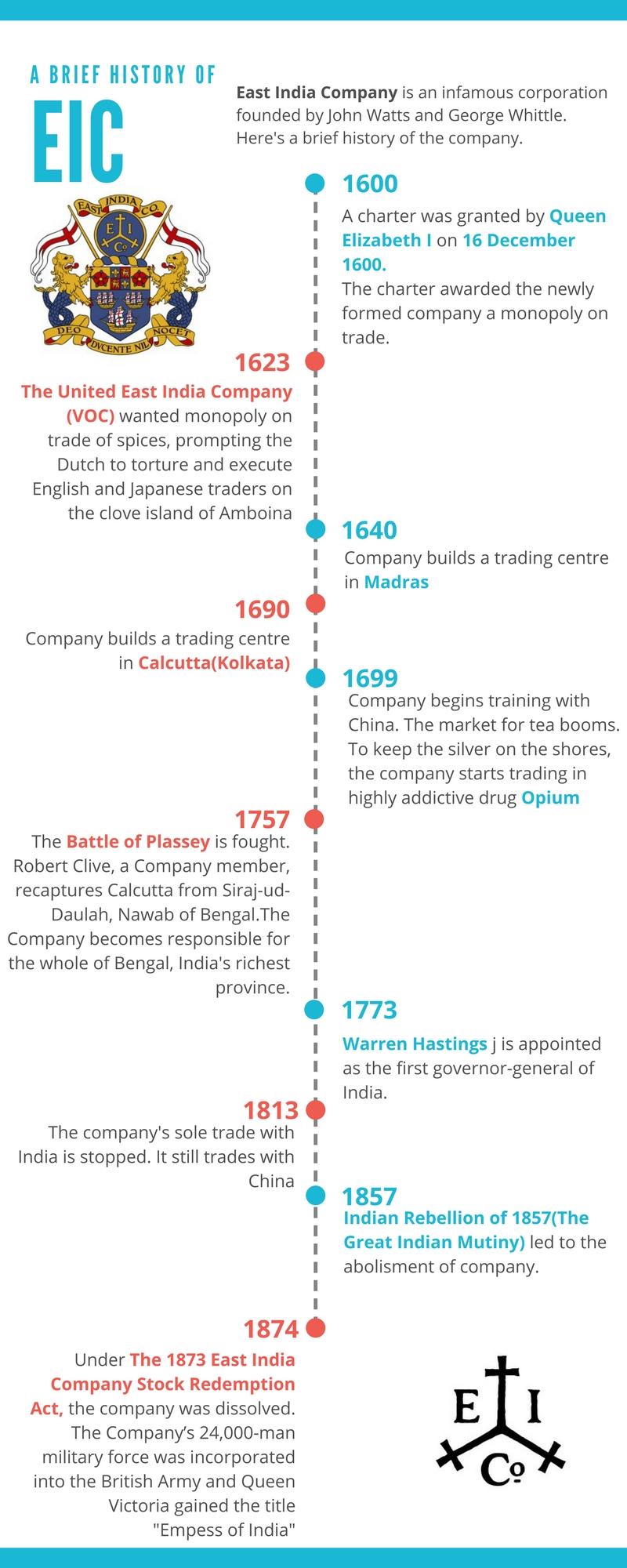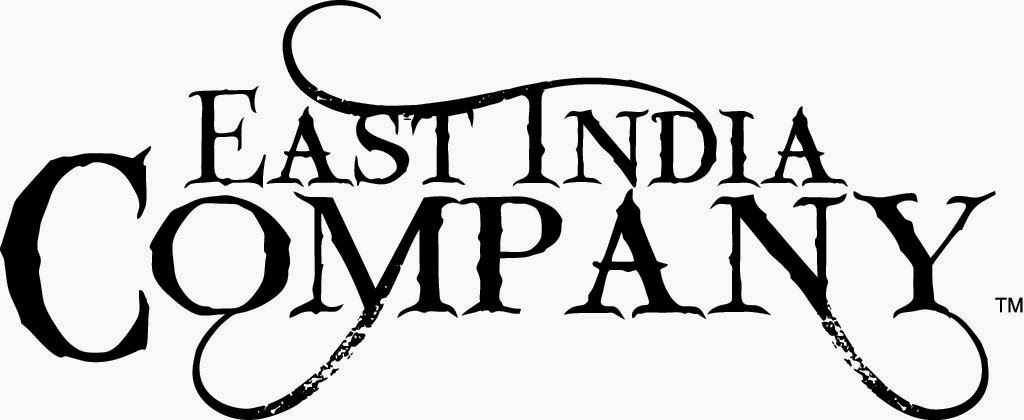Overview
The East India Company (also called English East India Company, formally (1600–1708) Governor and Company of Merchants of London Trading into the East Indies or (1708–1873) United Company of Merchants of England Trading to the East Indies, informally John Company) was formed on 31 December 1600, making it the oldest among all East India companies.
The royal charter granted the company monopoly over the trade in East for 15 years. At that time the company comprised of 218 men consisting of 24 directors.
The charter authorized a new era in the world of business. A new kind of company in Britain – a joint-stock company, a norm in today’s era. Thanks to charter, the company enjoyed a political monopoly while being independent of the government.
The company traded in various goods and services like spices, textiles, indigo, saltpetre, slaves, opium, tea, and porcelain.
Over the years, the company had only one motive – Profit.
Why this Company
“East India Company weren’t an evil organization that went around deliberately oppressing people, but they were driven by profit, and how familiar is that now?” – Steven Knight
One of the first multinational corporations, EIC is a company that changed the landscape. Starting from a trading company and paving way for the imperial Britain, it’s fascinating from a business point of view to understand where they went wrong. The company closed shop deeply in debt, despite the political monopoly it enjoyed for almost 200 years. In the world of large corporations, having such a focused goal, and lack of incentive and accountability to only the shareholders can lead to. And to think, English East India Company was the diplomatic one, compared to the coercive Dutch VOC. Or at least they started that way. And then Battle of Plassey happened, which turned the structure of the company. From a trading company, it became a mismanaged institution ‘well-versed in tyranny, plunder, oppression, and bloodshed’. The company was a global giant, not only due to way it shaped the modern corporation, but also the sheer size of its operation in that era.
If we are to understand the corporations of today, we must grapple with the corporations of the past. Corporations are forever struggling between the search for power and fair trade.
Core Competency and a thirst for Profit
The East India Company Mission, Vision, and core were same throughout its run- Profit.
They amassed a huge product portfolio over the years; and yet they never settled on one. From spices to opium, it seemed as if EIC tried it all. On one hand, we can say that the company was so focused on one product for so long that it never branched out, but on the other hand, it never developed a core competency beyond an aggressive need to make profit at any and all cost. After all why else would a trading corporation decide to get into governance?
Due to this, there was no long-term strategy implemented by the corporation. The only reason they succeeded was the financial and political backing of the crown – and a good dose of luck (Similar to the oil industry and its Myopia). On itself, it was not a planned manner that led to the subsequent growth and fall of the company. It is an almost accidental survival, although one must give credit to the political tight rope balancing act played by the company. By making the politicians shareholders, they had a (unethical) hold on the House of Commons, which helped the company in the long run.
And this thirst for “profit” was not only on the corporation scale but also on a personal level. They followed a version of Tom Peters’ “tight-loose management” giving more freedom to the employees (More due to technological limitations than any other reason). The British EIC allowed its employees to take part in private trade (as opposed to its counterpart, VOC). For European citizens to travel and settle overseas was a huge risk on a personal level. Add to it, the low salaries that they were being paid. The only incentive they had was their own private enterprises. British EIC, in a brilliant move, made itself one of the best corporations to work for. And yet, here they become the victims of their own strategy. Initially, it worked as a brilliant strategy as it encouraged the employees to look into new avenues. However, that did not last long, as the employees were more concerned about amassing a private fortune and less concerned with the welfare of the company as a whole.
Adding to all that, the political unrest in the Mughal Empire of India led to a heel-face turn of the company. In 1756, Siraj-ud-daulah, Nawab of Bengal (Britain’s most profitable port) demanding duties over the personal trade of the employees (The farman from Aurangzeb only exempted the company from paying duties ), the company had a decision to make. As the Nawab was not a strong military power, and the British could not concede Bengal, the obvious solution for the company was retaliating by force.
Again the corporation had to take drastic measures to cover the taxes unpaid by its employees. And this set precedence for the company. When Mir Jafar(“Puppet King”) started creating trouble for the Britishers, he was replaced. The trend continued till Treaty of Allahbaad, in 1765. This opened the eyes of British East India Company to a new model. The Treaty of Allahbaad gave EIC the rights to collect revenue from three provinces – Bengal, Bihar and Orrisa. And now they could invest these revenues into business instead of importing gold and silver. This led to a realization that the annexation of Indian States could be the start of a new era for the company, a more imperialistic era.
And this led to a Market Expansion by the EIC. They followed all three major strategies – build, buy, and ally (Initial Settlement, Doctrine of Subsidiary Alliance, and Doctrine of Lapse).
However, this expansion came at a huge cost. It almost went bankrupt in 1771 and had to be bailed out by the government. And yet we know that the company was created for profit. So to finance the military expansion, the company resorted to exploitation of local population, through high taxes, which led to further discontent among the people, finally leading to the first war of Independence, which marked the end of EIC.
As we saw, the end of 1756 brought a major change in focus for EIC. They became administrators from traders. Let’s look at the PEST analysis of the company during that time.
PEST analysis is an analysis of the external macro-environment that affects all firms. P.E.S.T. is an acronym for the Political, Economic, Social, and Technological factors of the external macro-environment. Such external factors usually are beyond the firm’s control and sometimes present themselves as threats.
Political Analysis:
The EIC had a monopoly granted to it by the British Charter. This gave them an undue advantage, not only from an economic point of view, but also from a social point. As they were the sole voice of the crown.
The EIC, until 1756, has always preferred diplomatic solutions as opposed to coercive solutions, giving them certain goodwill with Indian provinces.
The fall of Mughal Empire and the general distrust among Indian provinces lead to political instability in the area.
Political instability in Siraj-Ud-Daulah ‘s court
Economic Analysis:
The relations between EIC and Bengal had deteriorated over time. The new Nawab of Bengal was unhappy with the conduct of EIC employees.
British EIC could not afford to concede Bengal
They were also against paying the fine to the Nawab, over the fear that it will set precedence along with the general distaste the company had towards the idea
Social Analysis:
Siraj had already been warned of impending defeat by his astrologer (who had possibly been bribed).
Siraj also mistrusted his generals, which led to weak military structure.
Technological Analysis:
It took few months for news of Nawab taking over the Calcutta to reach Clive due to technical restrictions of the era.
As it could take months for the exchange of information between Indian arm of EIC and the Britisher’s end, it gave a certain freedom to the employees in India to deal with problems at they see fit.
Technological limitations made micromanagement impossible. This also led to mismanagement, and employees working for their own gain and the gain of the company. This led to crown trying to take more active control.
Conclusion
The Mother of all modern Corporations, it is necessary to study the practices of East India Company. As a corporation, it has a rich and fascinating history and it provides a template for any company that has to navigate between the interests of the state and that of the corporation. Which is not limited to state-owned corporations (partially or completely), but all the global corporations. The scope of East India Company and its deterioration from a trading company to the face of imperial Britain makes it imperative for the present companies to have a hard look at their practices and ensure that they do not just serve the interest of the shareholder but the community as a whole.
One wonders what the world could have been if R. Edward Freeman’s Stakeholder theory was coined 300 years before.
Sources and References
http://www.bl.uk/learning/histcitizen/trading/timeline/timeline.html
http://www.paulrittman.com/EastIndiaCompany.pdf
The Corporation that Changed the World – How the East India Company Shaped the Modern Multinational. by Nick Robbins (2006)
Gangs of America; The Rise of Corporate Power and the Disabling of Democracy– by Ted Nace
https://tejas.iimb.ac.in/articles/East%20India_Tejas_Mar17.pdf
The Trading World of Asia and the English East India Company (1660-1760). by K.N. Chaudhuri (1978)
http://www.rh7.org/factshts/eindiaco.pdf
Dalrymple, William (4 March 2015). “The East India Company: The original corporate raiders”. The Guardian. Retrieved 2017-06-08.
“First EIC Voyage”. thinkingpast.com. Retrieved 2017-02-18.</

